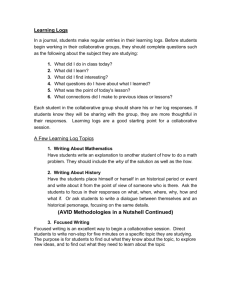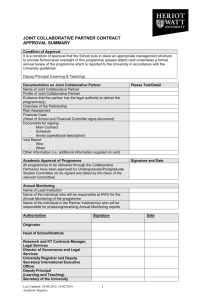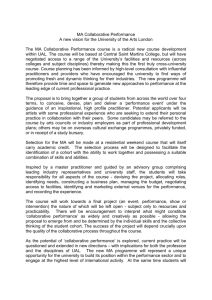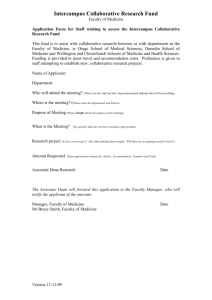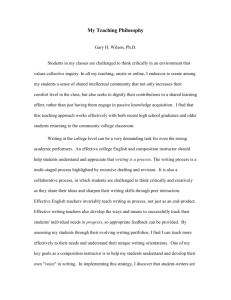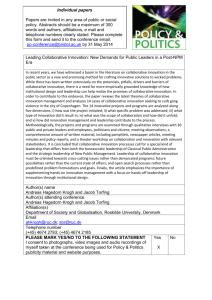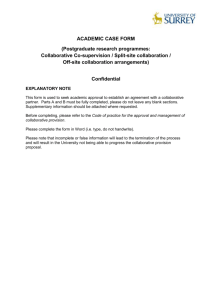Collaborative Documentation - Cummins Behavioral Health Systems
advertisement
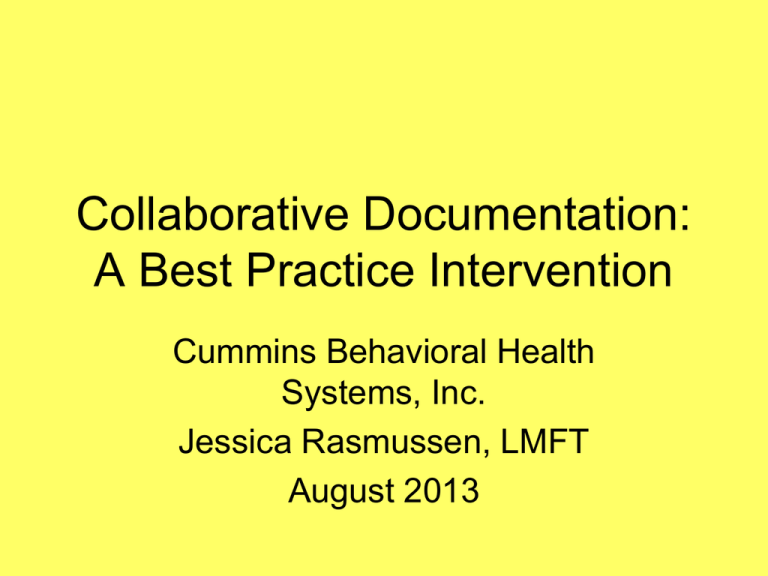
Collaborative Documentation: A Best Practice Intervention Cummins Behavioral Health Systems, Inc. Jessica Rasmussen, LMFT August 2013 What is Collaborative Documentation? • Difference between Collaborative and Concurrent Documentation. • Collaborative Documentation is a process in which clinicians and consumers collaborate in the documentation of the Assessment, Person-centered Treatment Plan, and Progress Notes. • Collaborative Documentation is a clinical tool that provides consumers with the opportunity to provide their input and perspective on services and progress, and allows consumers and providers to clarify their understanding of important issues and focus on outcomes. Importance of CD use with Home to Stay • The Home to Stay Program champions a consumer’s ability to make progress so they can live an independent and fulfilling life consistent with their own goals • CD offers the opportunity for a consumer to empower themselves to define their goals and ensure they are holding themselves and their providers accountable to those goals Three Important Aspects • Person Centered Approach to Treatment and Documentation • Improves Treatment Outcomes • More efficient and Accurate Documentation Person-Centeredness • Research demonstrates improvement in consumer engagement and involvement; Fewer no-shows/ cancellations; • Improved treatment compliance; • Supports and is Consistent with Person-Centered Treatment Planning; Treatment Outcomes • Since CD provides consumers with the opportunity to give their input and perspective on services and progress- from assessment to discharge, treatment investment is increased. • Allows consumers and clinicians to clarify their understanding of important issues and focus on outcomes using solution-focused philosophy. -Example: What was heard during the session? • Evidence-based, supported by research. Efficiency: Disposing of Time Wasters and Preventing Burnout • Collaborative Documentation will: – Save time and produce quality documentation – Help focus the clinical hour / skills session What is Required for CD? • • • • • • • • A willingness to try it A computer For providers in the office: setting up your office. For providers in the field: a good battery and car charger; privacy. Basic keyboarding skills Personal organization Use of a structured session Practice and perseverance How to begin? Role Induction • This is your note, chart, care, and treatment • Writing the note now will help us ensure a higher quality note that better represents your progress • Your opinions and feedback are important in the development and maintenance of your treatment goals • We want to make each service the best possible service for you that we can • We will only document during the last few minutes of your session Transitional Strategies • Interact normally with the consumer during session, taking notes on a pad saying, “I’m going to jot down some notes so we’ll remember them when we write our note at the end of the session.” • At the end of the session, say, “Let’s review and write down the important parts of our session today.” Role Induction for Existing Consumers • “As you know, I normally write notes about our sessions afterward in my office. We now believe that there is value in making sure that you contribute to what is written in your notes. Also, I want to be sure that what I write is correct and that we both understand what was important about our session.” • “So from now on, at the end of the session, we will work together to write a summary of the important things we discuss.” Common Concerns • It’s not fair to consumers. • CD takes away from treatment. • There is no clinical benefit for children, paranoid, or psychotic consumers. • I need time to think about what I want to write before I complete the note. • You cannot complete CD during a crisis situation. It Works! • “Aside from the obvious therapeutic benefits such as better treatment and better notes, it simply came down to two things with me. It was equal parts selfishness and self discipline. I give 150% when I am here. I just felt as though I did not need to give another 20% when I got home at night. I just felt like this was not good “self care” for me or my daughter. The other part was just good old fashioned self discipline during the appointment with the consumer to set the expectation, give the cons a reminder when note time was getting close and sticking to my guns! There are those days that you feel like you are putting out fires but even if I have one night a week that I have 1 or 2 stragglers to finish Its still been life changing!! And you can quote me on that! My higher functioning cons really take ownership in the process as well, plus 2 heads is better than one, right?” --Melynda Yater, Life Skills Specialist for Home to Stay • ““My consumer who I have worked with for a very long time is paranoid of the computer. But after a few months of doing collaborative documentation, she is now working on becoming her own payee. I think it’s because of watching me type out the progress she has been making. She did not realize she was managing her money as good as she was until I was typing out her progress and talking about it with her.”-- Stephanie Austin, Life Skills Specialist for Home to Stay” Summary • Collaborative Documentation is a clinical tool to be used with consumers • CD will improve treatment outcomes, prevent employee burnout, minimize organizational risk and increase person centered care • CD can begin at any time!


